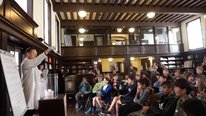- Mark Guzdial
- https://computinged.wordpress.com
- Lead PI
- Expanding Computing Education Pathways (ECEP)
- http://www.ecepalliance.org
- Georgia Institute of Technology
- W. Adrion
- https://people.cs.umass.edu/~adrion/
- ECEP PI, Professor Emeritus
- Expanding Computing Education Pathways (ECEP)
- http://www.ecepalliance.org
- University of Massachusetts Amherst
- Sarah Dunton
- ECEP Alliance Manager
- Expanding Computing Education Pathways (ECEP)
- http://www.ecepalliance.org
- University of Massachusetts Amherst
- Barbara Ericson
- http://barbara-ericson.strikingly.com
- Senior Research Scientist
- Expanding Computing Education Pathways (ECEP)
- http://www.ecepalliance.org
- Georgia Institute of Technology, Expanding Computing Education Pathways
- Renee Fall
- co-PI
- Expanding Computing Education Pathways (ECEP)
- http://www.ecepalliance.org
- University of Massachusetts Amherst, Expanding Computing Education Pathways
- Deanna Roux
- Communications Manager
- Expanding Computing Education Pathways (ECEP)
- http://www.ecepalliance.org
- University of Massachusetts Amherst
Public Discussion
Continue the discussion of this presentation on the Multiplex. Go to Multiplex












W. Adrion
ECEP PI, Professor Emeritus
Hi! This is Rick Adrion one of the ECEP PIs. We are happy to answer any questions you may have.
Mark Guzdial
Lead PI
I'm Mark Guzdial, one of the ECEP PI's and a co-presenter here. I'd love to hear how your state is trying to broaden participation in computing. We have a goal of "CS for All." How do we make sure that we get to *ALL*, especially those students who are currently not participating in computer science education?
Sarah Dunton
ECEP Alliance Manager
I'm Sarah Dunton, the ECEP Alliance Manager. I look forward to reading posts about the work that you are doing to broaden participation in your state. Let us know what tools and resources would help you advance your work to broaden participation in computing. You can learn more about the alliance members working with ECEP, and access resources on our website at: http://ecepalliance.org/
Neil Plotnick
Teacher
As someone who has been a HS CS teacher, I recognize that there is a lot of work that needs to be done. I'm curious what types of actions seem to be most in demand. For example, is the greatest need finding and training CS teachers? Do school districts struggle with defining the place that CS should have in their broader curriculum? While many state governments have adopted CSTA standards for schools, how is licensing of teachers taxing education boards? What types of resources seem to be most in demand?
Mark Guzdial
Lead PI
Hi Neil,
The top priority in each state varies by the state. We wrote about some of those issues in this article in CACM (http://dl.acm.org/citation.cfm?id=2856455) and in this blog post (https://cacm.acm.org/blogs/blog-cacm/198790-state-of-the-states-progress-toward-cs-for-all/fulltext).
Yes, growing the number of teachers is a problem everywhere. The curriculum issues vary by state. In some states (e.g., Georgia and South Carolina), curriculum is determined top-down, so the curriculum is defined and then disseminated. Both of those states have CS classes and curricula defined. In other states (e.g., Massachusetts and California), individual districts define everything from curricula to high school graduation requirements, so there are hundreds of classes in each state and a wide variety of policies to negotiate. Some states have CS teacher credentials/licensure defined (e.g., Indiana), others are developing standards, and still others (e.g., Michigan) are scrapping CS teacher credentials. Less than 10 states have CS curriculum specialists/coordinators in their state departments of education. Without expertise in the state department, CS may not be valued or managed with full understanding of the subject.
That's a dense answer. The bottom line is that there isn't one answer about what is most in demand. US states are so varied, that there are 50+ sets of issues and priorities.
W. Adrion
ECEP PI, Professor Emeritus
Neil - For details, see the State of the States report (http://www.edc.org/sites/default/files/uploads/...), co-authored by ECEP, Code.org, Education Commission of the States (ECS), Education Development Center, Inc., the Massachusetts Computer Attainment Network (EDC/MassCAN), and SageFox Consulting Group
Neil Plotnick
Teacher
Not surprising to see that we are confronted with an "alphabet soup" of different curriculum guidelines, teacher license regulations and state initiatives. The good part is that plenty of choices are available for teachers looking to find resources they can use. The negative aspect is the lack of consistency nationwide. I'm not suggesting that we adopt a Common Core approach. Perhaps the CSTA curriculum guidelines are starting to gain traction and we will see a more uniform acceptance of what K-12 CS education should resemble.
Nicole Reitz-Larsen
Educator
I appreciate you all taking the lead to build an alliance where CS leaders can come together to take inventory of what is going on in each state and how to best support each other. This is a daunting task and as mentioned in earlier posts, the supports vary.
Can you share a little more about the four-step process toward state-level computer science education reform you all are working on and how you are able to collaborate and work on this project being that you are all over the nation.
It was mentioned a lot of times it is a motivated teacher or professor in the state that wants to get things moving, what strategies do you suggest to help get state leaders, industry, school districts and schools onboard to support the computer science movement and these motivated folks who can't do it alone while teaching.
Mark Guzdial
Lead PI
Our four step model (described in this CSTA Blog Post) is for states just getting started with CS Ed:
Neil Plotnick
Sarah Dunton
Nicole Reitz-Larsen
Educator
Thanks for sharing your model. I think it is great helping states set up networks that can help them be successful and sustainable.
Sarah Dunton
Debra Bernstein
Thanks for this video, and sharing information about ECEP. I appreciate that school-based efforts are an important part of encouraging states to think about, and plan for, CS education. But I know that ECEP also supports informal learning opportunities (like summer camps). Can you say a little bit about how that balance of formal and informal considerations plays out? Is it hard for states to consider both types of resources?
Barbara Ericson
Senior Research Scientist
To improve diversity in computing we think that it is important for every student to have an engaging exposure to computing, but that won't happen in most states for years. In the meantime, we recommend reaching more underrepresented students through informal means such as computing summer camps. We have run workshops to help states learn how to plan and run financially sustaining computing summer camps and they have competed for up to not quite $5,000 in "seed" funding for equipment for the summer camps. We have also piloted Rise Up 4 CS in several states to help underrepresented students pass Advanced Placement Computer Science (CSA and CSP) by having undergraduate students lead help session and serve as near-peer role models. This effort has mostly been funded by additional funds from Google and Oracle.
Most states in ECEP start by forming a state team, then they try to understand the current situation in their state by creating a landscape report. States also have held summits to increase support, develop a strategic plan, and increase awareness. States have focused on training the people who train the teachers, creating standards, and teacher credentialing. Some states have added more computing summer camps, but this effort is limited as we only had $15,000 a year to award in "seed" money. Oracle contributed an extra $20,000 one year, which we used to increase the number of awards that year. Most the awardees continued to run the camps after the "seed" funding.
ECEP doesn't dictate the priorities for states. We offer services like the summer camp workshops and mini-grants and the states determine what they think is most important. Right now, states are mostly focused on summits, standards, teacher professional development, and their strategic plans. Puerto Rico has been translating the ECS curriculum to Spanish.
Sarah Dunton
Sarah Dunton
ECEP Alliance Manager
Debra - the sustainable summer camp model is an intervention that has always been a part of ECEP's work. You can read more about Barbara Ericson's work on the ECEP website: http://www.ecepalliance.org/computing-summer-camp-workshops.
In our 16 states and Puerto Rico there are many informal programs offering a range learning opportunities in CS, computational thinking, robotics, and digital literacy. Informal and formal CS education make up the education ecosystem in every state. The focus on frameworks, standards development, and graduation requirements are laser focused on formal education, but informal educators can and should be at the table in these discussions.
As states begin to coordinate their reform efforts, we encourage them to build diverse leadership teams that will support strategic and sustainable CS education policy reform. Many states have informal programs engaged in their change efforts and are considering both types of resources. Reaching all students and increasing diversity in the CS pipeline requires that we advance and improve CS education wherever the students are.
Debra Bernstein
Thanks, Sarah and Barb, that's helpful info. I don't doubt that, as Sarah said, informal educators should be at the table. I was more wondering if it was hard for states to imagine (and make happen) a formal + informal approach, since sometimes the steps for moving forward in formal education environments (like the ones mentioned in earlier comments - standards, teacher PD, etc.) seem more straightforward. But it sounds like ECEP provides resources to make computing summer camps straightforward too, which seems like the right way to introduce/support the idea. It sounds like a good model.
Sarah Dunton
Lien Diaz
Sr. Director
Fabulous team on this project! ECEP has made great accomplishments in gaining state commitments on expanding CS opportunities for students. How can the community help get the word out about ECEP so that more states can become involved? Is this desired? I'm also wondering what recommendations would you provide for leaders/educators in schools/districts that are just beginning a CS program who are not part of ECEP? How would they know to contact ECEP and what is the best way for them to obtain additional support via ECEP?
Sarah Dunton
ECEP Alliance Manager
Lien, thanks for your comments and questions. We recognize that other states and leaders in states may want to get involved with the work of ECEP. We put research, data and resources up on our website. We are always open to email inquiries and have provided initial coaching and resource sharing for non-ECEP states. Currently we have reached capacity at 17 states, but there is always talk of growth.
For leaders in schools/districts I'd encourage them to start surveying the CS education landscape and building a network. Who else is doing the work to create access to high quality CS education for underrepresented students? Who is working towards #CSforAll? Are there other CS projects in the state? The four-step model that Mark discusses above can be used at any level of CS organizing.
ECEP partners with organizations like CSTA, NCWIT, STARS and collaborates with the CS for All Consortium and Code.org to amplify our work. We know that the leaders in our 16 states and Puerto Rico share about their ECEP related work at conferences, trainings and PD events both locally and nationally. Every state leader is accessible through our website on the states page. In addition to our substantial network of state leaders, we have advisory board members, expert bureau members and collaborators that help to share the ECEP model.
I encourage anyone wanting to learn more about how to 'change their state' to email us at: ecep@cs.umass.edu
Further posting is closed as the showcase has ended.